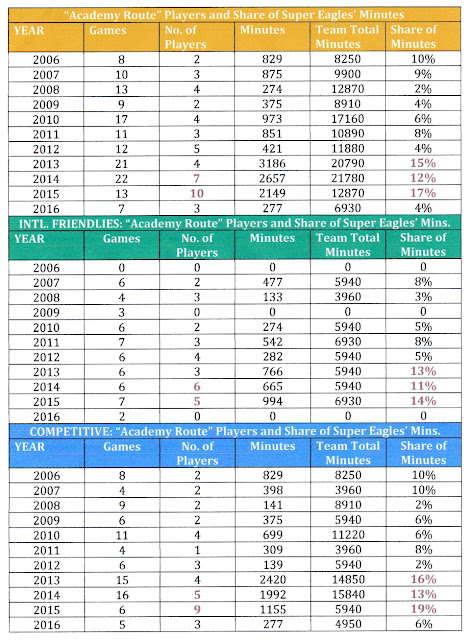'Academy-route' Players and Share of Minutes at Super Eagles Level
Increasingly, many Nigerian players leave the country from youth teams or academies to clubs in Europe where they are eased into the regular club via the club's youth team. Of course, this is less of a risk for European clubs and, thus, easier access to Europe for Nigerian players.
However, for players at the top tier of the Nigerian league, the path to Europe is more difficult for several reasons. First, they often must try out for a place in the main squad of the foreign team and their success depends on a variety of factors including performance, health, quality of remuneration, and availability of squad space. Thus, increasingly Nigerian league players are choosing the alternative route of North African and South African clubs as gateways to Europe.
Ultimately, then, it is not surprising that many Nigerian youth level players put off joining the top tier of the local league and instead seek access to developmental squads of foreign clubs. A recent example of this is Moses Simon who spurned an opportunity to join Kaduna United in the Nigerian top-tier and instead waited for opportunity to head to a foreign club.
Based on the above, it seems likely that an increasing number of Nigerian players at the Super Eagles level will consist of players who are largely bred in Nigeria but chose not to play top tier Nigerian football before heading for Europe. The condition "bred in Nigeria" is necessary to differentiate this group of players from those who have appeared for Nigeria but only because they were born to a Nigerian parent but were not bred in Nigeria.
Data provided here explores the effect on the Nigerian national team of this behavior by Nigerian football labor in the last 10 years. We examine the share of minutes played by such players designated "Academy-route" players and the number of them appearing on the national team on an annual basis in the last 10 years.
Results
The table below reveals an increasing number of "Academy-route" players beginning to show up in the national team with as many as 10 of them appearing for the national team in 2015. Based on our exploratory findings, the ten were Kenneth Omeruo, Ogenyi Onazi, Moses Simon, Anderson Esiti, Lukman Haruna, Sylvester Igbonu, Izunna Uzochukwu, Wilfred Ndidi, Kelechi Iheanacho, and Obafemi Martins. None of those players appeared for a top tier team in Nigeria before playing overseas. The likes of Onazi (El Kanemi) and Omeruo (Sunshine), as far as we can ascertain, were in youth teams of Nigeria's top tier clubs but did not feature for the main team before leaving for a foreign club. Additionally, the share of minutes earned by such players in the Super Eagles has increased with a high of 17% in all games in 2015 and 19% in competitive games in the same year. The low number in 2016 is exaggerated by the national team playing few games so far and a significant number of those games were restricted to players based at home.


Comments
Post a Comment